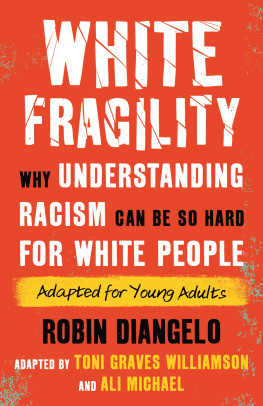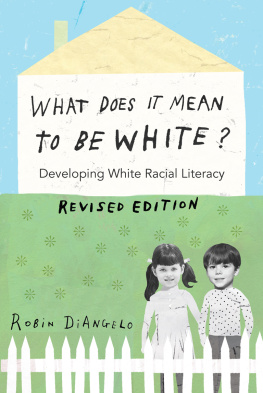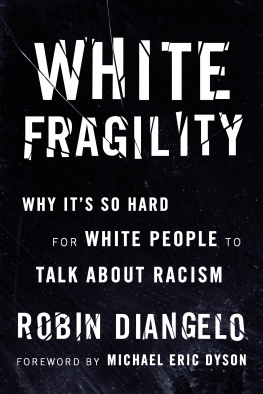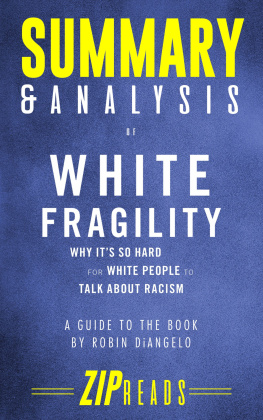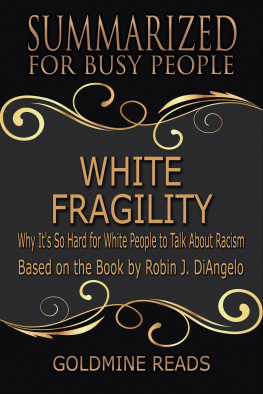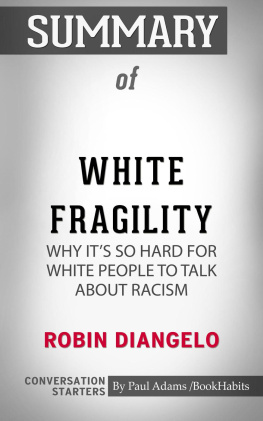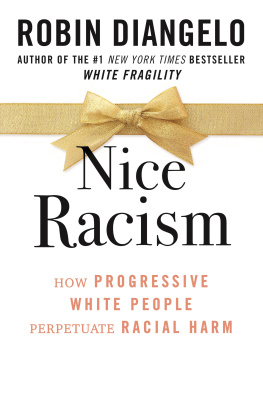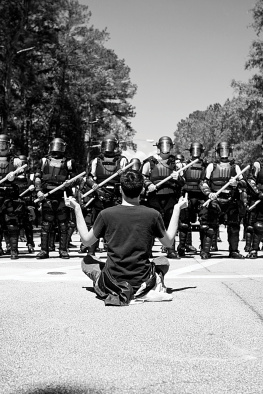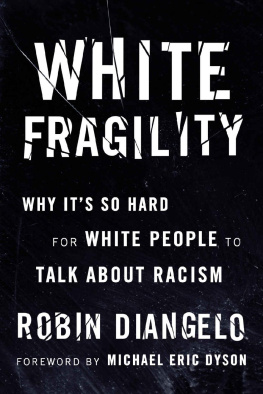Contents
Pagebreaks of the print version
Guide


To young people of all racial backgrounds... because we know that you will change the world.

HOW TO READ THIS BOOK
Reading this book is meant to be an opportunity to put on a new pair of lenses for looking at the world around you. Its not the kind of book to read through without stopping.
We encourage you to slow down, get a blank notebook for journaling, and take time to reflect as you read each chapter. Write down any thoughts and questions you have as you go. When youre finished, go back through your notebook and see whether you have new answers to your old questions. Or new questions about old ideas. There are afterthoughts at the end of each chapter, which can prompt journal reflections or discussions with friends.
As you move through this book there will be times that you may feel uncomfortable. You may have already felt that way before this page. Dont worry! Discomfort is a normal part of talking about race, particularly because so many people were taught not to do it. When you do talk about race and you feel discomfort, its not a sign that something is wrongits actually a sign that you are doing something right.
Think about all the times that you have been in your discomfort zonelearning something new, going to a new place, meeting new people. Many experts believe that you cant learn without being uncomfortable. And yet, its also true that our bodies often try to keep us comfortable. If we Its precisely because race conversations are rare in our society that they are going to be uncomfortable. And that also makes them special. There is incredible potential for growth and change for those of us who are willing to stand together in our discomfort zones.
Journaling and engaging with the discussion questions will help you notice how your feelings and reactions change as you read. To help you track your bodys reaction to this conversation, we offer a few guiding questions to return to when you feel the discomfort. When you become uncomfortable or perhaps disagree with what is being said consider the following questions:
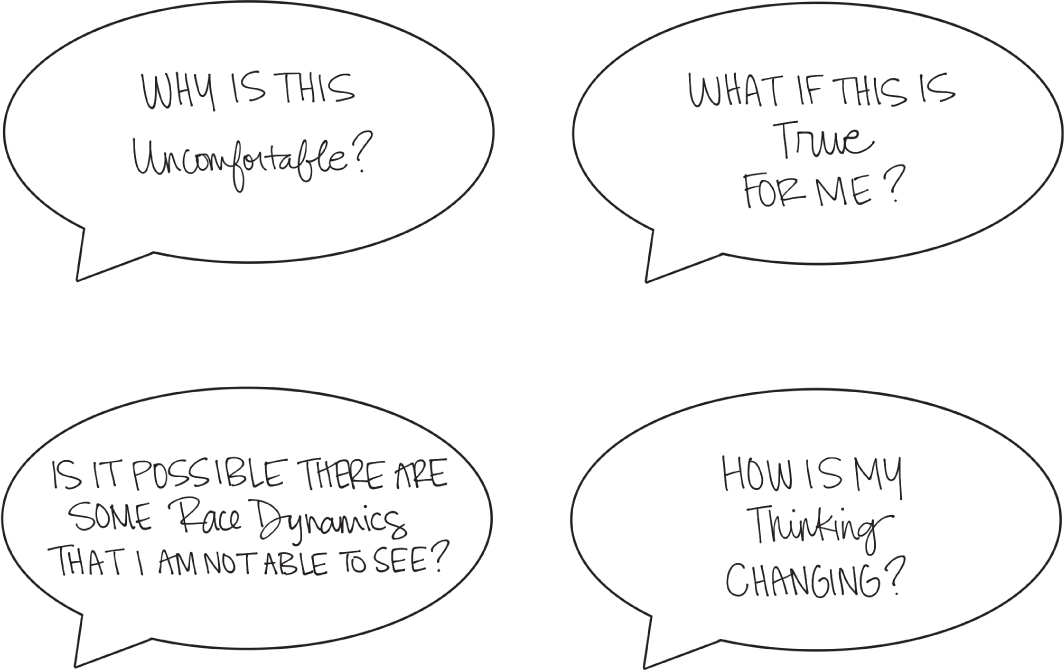
Content Warning
When we were writing this book, we received feedback from well-intentioned readers who suggested that we may want to include content warnings in certain sections, particularly one where we mention sexual assault. We sat with this feedback and appreciated it, but we also questioned it. The truth is, theres a lot of material in this book that might make you uncomfortable, that should make all of us uncomfortable. First, as we have acknowledged, some people will be uncomfortable simply because it can be hard to talk about race. Thats real. Second, we do mention sexual assault and rape, both in the modern context and in the context of enslavement. Both deserve a content warning. But third, we write in this book about how racism impacts People of Color. We write about innocent Black teenagers who have been killed or incarcerated. We write about the increased violence against Asian Americans during COVID-19. We write about the ways that Latinx people are made to be second-class citizens. We write about how Native people have been dispossessed of land, livelihood, and culture. The things we write about are traumatic. Racism is brutal.
So we want to issue a blanket content warning... for all of it. We have written this book in a way that we hope will introduce painful material slowly and intentionally. We want to support our readers in taking in the information without being overwhelmed. But we cannot pick and choose where to put content warnings because racism is traumatic. We hope reading this book will help you develop the skill and agility to challenge racism in ways that change this reality.
Other Things to Know About the Book
Youll notice that wethe narratoris plural! We includes both Toni and Ali. We are a multiracial team (Toni is Black, Ali is White). Otherwise, this book is our collective adaptation of Robin DiAngelos book White Fragility. It is an adaptation of her words and work, but it is not the same book. Here are some of the ways it is different:
It has been adapted for young adults to include developmentally appropriate material in terms of language, examples, and concepts.
The author and artist team is made up of one Black woman, one Black man, and two White women, who worked in consultation with Robin, a White woman.
We have worked with youth readers, youth focus groups, and teachers to determine what material and language will be most relevant for a Young Adult adaptation.
We have added images and drawings to help the concepts come alive on the page.
This version includes a chapter on navigating media... social and otherwise.
This version also includes a chapter on taking action. Once you understand white fragility, what can you do? You will find some answers in .
As you flip through the book, you will see portraits of some of the scholars and activists whose work influenced Robins theory of white fragility. Robin connects to other authors, citing them and honoring their work. And, like most authors, she helps readers see their work in a new light by putting a unique frame around the whole. In this case, she uses her own experience and research to develop the concept of white fragility. We chose to highlight some of the scholars whose work Robin deeply respects, to give you a sense of the intellectual roots of this concept that you are learning.
Throughout the book, Toni and Ali share personal stories. They are marked as such with the name of the author following the story. You will also see scripted quotes from Robin. These quotes are impactful statements that appear here exactly as they appeared in the original White Fragility.
Finally, you may notice that we dont start talking about white fragility in earnest until
INTRODUCTIONS
Introduction from Robin DiAngelo, Author ofWhite Fragility
I grew up in poverty, in a family in which no one was expected to go to college. I understood at an early age that the world was not a fair place, but I had only ever thought about how it was unfair to me. Like most White people, I lived a segregated life. My neighborhoods, my schools, my friends, and my teachers were all mostly White. At the same time, I believed I was completely open-minded when it came to race and that I knew all I needed to. Many White people thought this way, even though we didnt talk openly about race or study it in school beyond being told that Dr. Martin Luther King, Jr. had ended it. But one day I took a job that required me to lead discussions on racism in the workplace. This was the first time in my life that I had ever talked directly about race, and I had never discussed race before in a racially mixed group. My worldview was shaken to the core during these discussions as People of Color shared their experiences and challenged my limited understanding. I felt like a fish being taken out of water.

